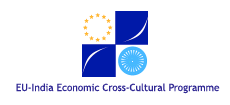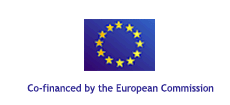Instituted by the B.M. Birla Science Centre and the International Centre for Mechanical Sciences
Coordinated by N. Ahuja (V.P. Indian Institute of Information Technology, Hyderabad) and Luca Chittaro (University of Udine)
Recent research and development in the field of Human Computer Interaction are deeply changing the way people use and interact with computers, from the input and the output point of views. The course examined both perspectives, first introducing participants to the new ideas proposed in the field, then exploring in more detail current applications and the techniques that make them possible. From the input perspective, the course dealt with topics such as computer vision, including the recognition of user's gestures and the computational relationships between images of the user's state and interaction. The application of these techniques to the emerging field of Augmented Reality (where virtual worlds are seamlessly mixed with the user's real world) was also dealt with.
From the output perspective, the course introduced the participants to the full range of new Information Visualisation techniques proposed in Human-Computer Interaction, from interactive 2D elements to Virtual Enviroments and 3D interfaces.
A university degree in computer science was required to participate in the course. Since Human-Computer Interaction is a multidisciplinary field that appeals to people with different backgrounds both in industry and academia, the participation of people with different degrees was considered, provided that they have a sufficient experience in computer science.
Instituted by the International Centre for Mechanical Sciences and the B.M. Birla Science Centre
Coordinated by Peter Hacker (ÖFPZ Arsenal, Vienna) and V.V.S. Gurunadha Rao (National Geophysical Research Institute, Hyderabad)
The course dealt mainly with the results of the joint research project carried out in Patancheru area. This area is a very typical example of the type of problems and conflicts, which are afflicting urban and semi-urban areas in India due to vested interests of industries, agriculture and human settlements.
The lectures focused on following points:
1. presentation of the results of the pilot project on groundwater pollution and management in the area of Patancheru to the concerned experts, industry and governmental institution representatives;
2. discussion on the past, present and future status of the groundwater contamination;
3. priorities of interests and an action plan including a discussion of a conflict of interests.
The course was devoted to experts working in public and private sectors and academic institutions in the field of urban hydrology including water resource management, conservation and environment pollution.
Instituted by the International Centre for Mechanical Sciences and the B.M. Birla Science Centre
Coordinated by Furio Honsell (University of Udine) and M. Radhakrishna (B.M. Birla Science Centre)
There are countless cases where software failures have resulted in loss of life, business crises, and other "digital woes". In life-critical software or when software is "mass-produced" naive testing is not enough. A more principled and rigorous analysis of software, based on formal logic and mathematics, is therefore necessary.
Since the introduction of Hoare's Logic and Denotational Semantics in the late 60's, a vast number of program logics and calculi based on rigorous mathematical models of computation have been introduced to this end. What we have learnt, is that probably there is no unique and ultimate system appropriate for all needs and circumstances. Rather, there are a number of irreducible viewpoints and properties we need to focus on, which are best dealt with using special purpose logical tools. Nevertheless there is also a need of defining general metamodels and metatools in order to be able to make sense within this multitude of different formal systems.
In order to illustrate the above issues, during the course we described various classes of computational models as well as the logics they validate, e.g. Process Algebras, pi-calculus, Petri Nets. We discussd general paradigms such as Final Semantics and general proof assistants such as Logical Frameworks.
Instituted by the International Centre for Mechanical Sciences and the B.M. Birla Science Centre
Coordinated by Bernhard Schrefler (University of Padua) and R.S. Ransing (Indian Institute of Science, Bangalore)
The course was designed for a wider audience including academic professionals, practising engineers, industry personnel and students. A number of case studies using numerical simulation was discussed in the workshop covering topics particularly suitable for Indian environment.
The course gave an opportunity to understand/refresh the basic knowledge on ground water modelling and introduce mathematical modelling principles. Isothermal and non-isothermal flow through porous medial were discussed in detail. A few case studies published in the literature has also been highlighted. Geomechanical problems are complex and involve deformation of some kind e.g. surface subsidence due to groundwater withdrawal. Computational plasticity was introduced so as to understand subsidence problems. Hands on training in undertaking computer simulation have also been given during this course and time was spent to discuss other software tools available on the internet.
Advanced numerical case studies involving disposal of nuclear waste, soil pollution due to chemical pollutants, heavy metals and non aqueous phase liquids were presented. Numerical and theoritical methods in environmental continum mechanics will also be covered. The course dealt with the durability of geomaterials such as natural stone, concrete and brick. Emphasis has also been given on Natural hazards and earthquakes. Seismic behaviour of Dams and slopes has also been discussed.
Instituted by the B.M. Birla Science Centre and the International Centre for Mechanical Sciences
Coordinated by B.G. Sidharth (B.M. Birla Science Centre) and Paolo Serafini (University of Udine)
The course provided an introduction to the use of probabilistic models in Combinatorial Optimization. Probabilistic techniques have proved to be powerful tools in developing heuristic solution methods, analyzing computational complexity issues, finding approximate solutions and even finding exact optima. The relevant mathematical background was reviewed covering in particular the basic issues of probability theory and Markov chains.
Particular attention was devoted to the concept of "rapidly mixing chains". On one side Markov chain models were used to analyse the behaviour of simulated annealing, a particular heuristic technique which can be applied when exact methods are bound to fail because of large data sets. On the other side Markov chains can be successfully used to sample randomly within a set. Since exact counting is intrinsecally difficult for many problems, it is natural to resort to approximate counting. In this case, given an error bound, we require a randomized algorithm providing a solution within the bound with a definite probability and a definite running time. Rapidly mixing Markov chains and clever sampling techniques can provide an answer to the problem.
The technique was applied to the problems of finding perfect bipartite matchings, counting the number of perfect bipartite matchings, computing the volume of convex bodies. Another application of random techniques concerns approximate rounding of solutions to find combinatorial objects. Simple randomized rounding techniques lead to interesting bounds for problems like integer linear programming, multicommodity flow, covering, packing and satisfiability problems. Stronger results can be found by defining appropriate semidefinite programming relaxations. To this aim some results concerning semidefinite programming were reviewed. The relationship with graph vector coloring and Lovasz theta function was also investigated.
The course was devoted mainly to researchers and/or post-graduated in computer science and operations research.

